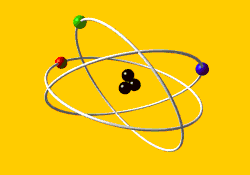Nuclides & Isotopes
 An atom that has an unbalanced ratio of neutrons to protons in the nucleus seeks to become more stable. The unbalanced or unstable atom tries to become more stable by changing the number of neutrons and/or protons in the nucleus. This can happen in several ways: converting neutrons to protons, converting protons to neutrons, ejecting an alpha particle (two neutrons and two protons) from the nucleus. Whatever the mechanism, the atom is seeking a stable neutron to proton ratio. In changing the number of nucleons (protons and neutrons), the nucleus gives off energy in the form of ionizing radiation. The radiation can be in the form of alpha particles (2 protons and 2 neutrons), beta particles (either positive or negative), x-rays, or gamma rays.
An atom that has an unbalanced ratio of neutrons to protons in the nucleus seeks to become more stable. The unbalanced or unstable atom tries to become more stable by changing the number of neutrons and/or protons in the nucleus. This can happen in several ways: converting neutrons to protons, converting protons to neutrons, ejecting an alpha particle (two neutrons and two protons) from the nucleus. Whatever the mechanism, the atom is seeking a stable neutron to proton ratio. In changing the number of nucleons (protons and neutrons), the nucleus gives off energy in the form of ionizing radiation. The radiation can be in the form of alpha particles (2 protons and 2 neutrons), beta particles (either positive or negative), x-rays, or gamma rays.
Is the atom still the same element? Only sometimes. If there is a change in the number of protons, the atom becomes a different element with different chemical properties. If there is a change in the number of neutrons, the atom is the same element, but becomes a different isotope of that element. All isotopes of one element have the same number of protons but different numbers of neutrons. All isotopes of a certain element also have the same chemical properties but have varying radiological properties such as half-life, or type of radiation emitted.
What if the protons and electrons of an atom are unbalanced? Normally, the number of electrons and protons is the same, so the atom is balanced electrically. Sometimes electrons are added or removed, and the atom carries a negative or positive charge. These charged forms of an element are called 'ions' of the element. This change affects the way the atom reacts chemically, but does not affect the stability of the nucleus--the atom's radioactivity.
About the Author
EPA US Environmental Protection Agency
 The Environmental Protection Agency is an independent executive agency of the United States federal government tasked with environmental protection matters.
The Environmental Protection Agency is an independent executive agency of the United States federal government tasked with environmental protection matters.


